FREE COMIC BOOK DAY – Saturday, May 6th
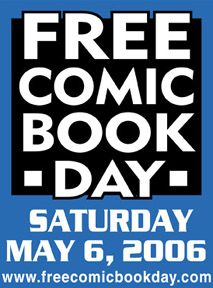 This Saturday is Free Comic Book Day, a massive industry-wide sponsored event where anyone can walk into a participating comic book store and pick up a free comic book – or a couple of free comic books. This is the fourth Free Comic Book Day. I’ve gone to the previous three, and they were a blast! It was great to see so many people that were obviously new to comics get so enthused about medium – and if the most recent sales figures from Diamond are accurate, then comic book sales overall have been increasing over the past four years. Something must be working!
This Saturday is Free Comic Book Day, a massive industry-wide sponsored event where anyone can walk into a participating comic book store and pick up a free comic book – or a couple of free comic books. This is the fourth Free Comic Book Day. I’ve gone to the previous three, and they were a blast! It was great to see so many people that were obviously new to comics get so enthused about medium – and if the most recent sales figures from Diamond are accurate, then comic book sales overall have been increasing over the past four years. Something must be working!
So this Saturday make a trip down to your local comic book store and bring a friend. Let him or her pick up a few free comics and wander around the store for a bit. While they’re busy doing that, why not finally get around to picking up that first trade for 100 Bullets, Rocketo, Conan, The Walking Dead or Queen & Country that you’ve been putting off.
Regardless, have fun!
You can learn more about the event and the various sponsors here – http://www.freecomicbookday.com/.
Wacky “Black Panther” Tale (Tail?) Leads to Big Wedding
By Mark Wheaton
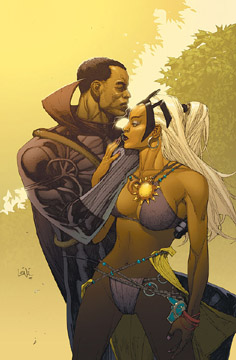 “Die, Infidels! Die by the sword of the Arabian Knight!”
“Die, Infidels! Die by the sword of the Arabian Knight!”
Every time “Black Panther” looks like it might miss a step – specifically due to the silly ‘Countdown to the Wedding of the Century’ banner over the title – it throws out a great issue like this one and renews one’s faith in Reginald Hudlin’s (how is he still writing this comic while running programming at BET?!) writing ability.
With the ongoing “Storm” mini, it should be painfully obvious to all that three issues from now, a double-sized, Storm and T’Challa wedding issue is going to hit, similar to the “New Avengers” annual that came out this week with Luke Cage finally marrying his long-suffering girlfriend. With that inevitability in mind and many issues to fill to get there, the thought that this arc could get silly and drawn-out is an easy one to voice. With #15, Hudlin shows that all the way to the altar, he’s planning to throw out not only a few surprises (as he’s done already), but also some crazy adventures that – while secondary to the main plot – will still be worth reading.
Issue #15 opens with a very Saddam Hussein-dressed/sounding lunatic creating a “new Arabian Knight” though he is warned that there already is one by his chief advisor. He quickly reminds said advisor that a mere few issues ago, Wakanda was invaded by a new Black Knight, so why not? The eye-rolling advisor agrees to just roll with it and the Arabian Knight is dispersed to invade Wakanda.
We leave this bit of comedy for a moment and head back to Black Panther and Storm – who still hasn’t replied to his proposal from the end of issue #14. They go back and forth over the old argument – that T’Challa abandoned Ororo years ago to avenge his father – and left her hanging. Why should she trust him now? But then, the woefully under-powered Arabian Knight shows up full of bravado and the two superheroes swat at him like a gnat while continuing their debate, making for some of Scot Eaton’s funniest artwork in the book.
Once that’s resolved, though, T’Challa takes Ororo back home after she agrees to spend more time with him to be “convinced.” The second half of the book then is all about Ororo visiting with T’Challa’s mother and – finally – saying “yes.” It was inevitable, of course, but handled well with humor and action. Does this mean there will be a “Cable/Deadpool”-style team-up book emerging with Storm and Black Panther? Who knows, but if it’s as good as this one, why not?
RATING: 
You remember Tron, right? Well it’s back, in comic form
By Graig
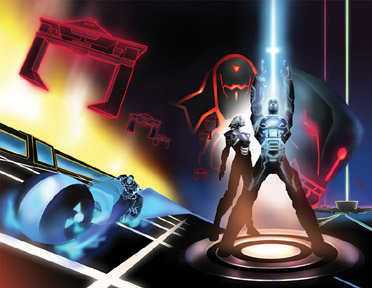 It shouldn’t be a surprise that Tron has spun off into a comic book series, but what is a surprise is how long it took for it to arrive, and in the most unexpected of places. Slave Labor Graphics is known primarily as an indie publishing house, gaining the most notoriety for the innovative humour titles it publishes, so it was a curious announcement when a deal was struck for SLG to publish titles based off a stable of Disney-owned properties of which Tron is a part.
It shouldn’t be a surprise that Tron has spun off into a comic book series, but what is a surprise is how long it took for it to arrive, and in the most unexpected of places. Slave Labor Graphics is known primarily as an indie publishing house, gaining the most notoriety for the innovative humour titles it publishes, so it was a curious announcement when a deal was struck for SLG to publish titles based off a stable of Disney-owned properties of which Tron is a part.
The source movie was some of the first cyberpunk fiction, and almost 25 years later, it still retains a unique style thanks to production techniques that have never been duplicated. It still feels fresh and otherworldly, despite how outdated the technology in reference or in producing the film might be. It ended rather finitely, so I wasn’t entirely sure where the comic was going to go…alas I forgot about the Tron 2.0 PC and X-Box video game. I’m not much of a gamer so I never did play it, but apparently it was an official sequel to the film. This comic, it would seem, is a follow-up to the game.
The game’s protagonist was Jet Bradley, unfortunately brought into the world of the living computer, run through a gauntlet of challenges (which I’m sure was some fine gaming action) and released back into the world upon completion of his task. The story picks up a little while after the events of the game. Jet is traumatized by his experience and is retreating into a (gasp) digital-free society, but his father goes missing and Jet enters the ENCOM labs only to find the latest iteration of the Master Control Program, Ma3a, has deceived him and is sucking him back into digital innerspace to engage in war.
Writers Landry Walker and Eric Jones have been in comics for a decade now (Little Gloomy, Kid Gravity) however I’m not at all familiar with their work. I was unsure what unknown-to-me names could come up with for a beloved childhood (and adulthood) concept, but they’ve absolutely grasped the ethereal techno feel of the movie, and have come up with an intriguing, if not immediately exciting, premise for this 6-part “Ghost In The Machine” storyline.
Artist Louie De Martinis has a firm handle on the environment of Tron, fully capturing the feel of the movie with digitally watercolored palette. His characters are occasionally blocky, and his facial renderings can be too rigid, but overall he serves the story well, and as a new-to-comics artist, his style will settle in as the issues progress. I’m definitely looking forward to more.
RATING: 
We Come to Praise Dan Slott, Hopefully Not Bury Him with The Thing #6
By Jeb D.
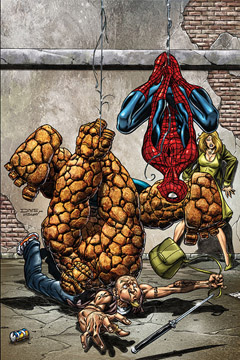 This should have been a happy occasion.
This should have been a happy occasion.
Issue #6 of The Thing should have been the wrapup to another great Dan Slott miniseries, like last year’s Spider-Man and Human Torch. More vintage Marvel-age fun, stories crammed with incident and action and excitement and humor– not just laughs, but genuine wit and real love for the superhero form.
Yes, a Dan Slott “Thing” miniseries would have been a great idea. Shame Marvel didn’t see it that way. Instead, for some reason known only to the accounting department, they decided to fly in the face of the realities of the current market and place the burden on Slott’s shoulders of launching and sustaining a new ongoing series for Aunt Petunia’s favorite blue-eyed nephew. And, surprise surprise, the sales haven’t set the world on fire (hell, the FF themselves don’t sell all that much these days), and suddenly there’s no solicitation for The Thing in Marvel’s upcoming July releases. So the same six issues that would have looked like a successful self-contained mini wind up looking like a failure. And that’s just not fair. Dan Slott continues to deliver more fun for your superhero buck than any other writer around.
As to this issue itself, well, let’s see… Ben ‘s up against the Sandman and Trapster, Spider-Man comes along and lends a hand with some cool moves, he and Ben engage in some hilarious dialogue (these two are, IMHO, the characters Slott was born to write), we get to see the good folks of Damage Control at work, Hercules turns up, we see what’s happening with Alicia’s love life, Ben once more finds that all his money can’t prevent the occasional “revoltin’ development”, and the story finishes with the perfect sendoff from the Yancy Street Gang. Nothing is forced, the pacing is ideal. Yep, that’s a 22-page Dan Slott comic, all right.
The departure of artist Andrea Divito (according to Slott, Marvel wanted to get him on a “higher profile” book—you know, the kind people buy) might actually have been no bad thing if the series were to continue, as the very versatile Kieron Dwyer seems even better suited to Slott’s approach (this issue does reinforce my belief, though, that Laura Villari’s coloring is too dark for the book, no matter who’s pencilling).
At this point, two more issues of The Thing have been solicited. I suppose it’s even possible they’ll actually come out, giving us such treats as a Slott-style Thing-Hercules brawl and Ben’s poker game. But it’s pretty clear that Marvel’s not planning to put a lot of effort into keeping the book alive. And, really, why should they? Personally, I don’t feel there’s any one “right way” to tell a comic book story, but given the number of people who complain about the so-called “made for the trade” storyline these days, it’s clear that not many of them are putting their money where their mouths are: Dan Slott’s books are invariably tight, well-plotted, and stuffed with entertainment. Those who measure their enjoyment by how long it takes them to read all the words should have a field day. But they don’t seem to care. And as far as I’m concerned, if today’s superhero readership won’t support what it claims to want, then it’s even more screwed up than I’d thought.
RATING: 
What Is The Sound Of One Hand Clapping? Usagi Yojimbo Knows
by Elgin Carver
 At one time one of the most popular genres of both comic books and strips was the funny animal, anthropomorphic characters, involved in high adventures. Mickey Mouse, Donald Duck, Mighty Mouse, Crusader Rabbit, and Atomic Mouse were just a few of the early strips and books, later reinvigorated in underground comics, most notably Air Pirates Funnies, and brought back to the fore, in a sense, in Teenage Ninja Mutant Turtles and Cerebus. None were better or more noteworthy that Usagi Yojimbo, the adventures of a samurai rabbit.
At one time one of the most popular genres of both comic books and strips was the funny animal, anthropomorphic characters, involved in high adventures. Mickey Mouse, Donald Duck, Mighty Mouse, Crusader Rabbit, and Atomic Mouse were just a few of the early strips and books, later reinvigorated in underground comics, most notably Air Pirates Funnies, and brought back to the fore, in a sense, in Teenage Ninja Mutant Turtles and Cerebus. None were better or more noteworthy that Usagi Yojimbo, the adventures of a samurai rabbit.
Stan Sakai, the creator of this most excellent series, is himself of Japanese ancestry. He has synthesized this genre and aspects of Japanese history into one of the best ongoing comics available today. Each book and story arc is crafted with the same sensibility and attention to detail that one expects from potters from Japan. First published in a Fantagraphics title Critter Comics as a series of short stories, then under the present name by the same publisher, it disappeared. Brought back by Mirage Comics, a short lived publisher, the title once again vanished, only to reappear under the Dark Horse imprimatur. As we near the 100th issue by Dark Horse, the wisdom in keeping this title going is proven and re-proven ever more strongly with each issue that is published.
In the context of what is printed in the vast majority of comic books today, this issue is an anomaly so striking that one cannot help but wonder that Sakai and Dark Horse had the temerity to place it on sale. There are no costumed superheroes, no violence (quite the contrary), practically no plot, no mega tie-ins, little text, and no cursing. The totality of this issue is the complete, step-by-step participation of a tea ceremony.
In Japanese society, among the educated and spiritual, there developed as an offshoot of Zen Buddhism, a sharing of the preparation and enjoyment of a cup of tea between a guest and host that encompassed the totality of the human experience in its highest form. The closest Western counterpart might be considered the taking of Communion (although many who are involved with either could justifiably disagree as important differences inherent in both). There is nothing more contained in this issue, if the phrase "nothing more" can be applied to such a deep and meaningful rite. Here, as in a Kurosawa or Miyazaki film, a moment is taken from the ongoing plot/action, to focus on a moment of quiet and sublime distraction.
If anyone asks me why I read comics, this title is what I would point to and this issue is the one I would use as an example. On the racks at your local comic shop, this issue is a gem sparkling in a coal pile.
RATING: 
What the…? Annihilation: Ronan #1
By Graig Kent
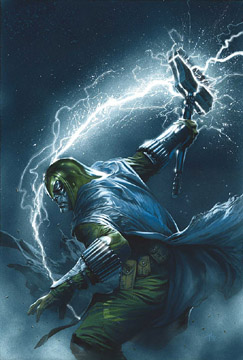 Last week I mused on the crappiness that was Nova, and how, despite the weakness of the character, the costume and his powers, in good hands an incredibly fun story was still crafted in the Annihilation spin-off. Well, as lame as Nova is, he’s got nothing on Ronan, a character I had extremely little knowledge of until this week. While I’m sure there are many out there who do have knowledge – fond memories even – of Ronan, I couldn’t count myself as one, and I still can’t after reading Annihilation: Ronan #1.
Last week I mused on the crappiness that was Nova, and how, despite the weakness of the character, the costume and his powers, in good hands an incredibly fun story was still crafted in the Annihilation spin-off. Well, as lame as Nova is, he’s got nothing on Ronan, a character I had extremely little knowledge of until this week. While I’m sure there are many out there who do have knowledge – fond memories even – of Ronan, I couldn’t count myself as one, and I still can’t after reading Annihilation: Ronan #1.
Ronan, The Accuser is a Kree judge, jury, and if need be, executioner. He roams the cities and planets doling out doses of Kree justice, I suppose, wielding his electro-gavel (or whatever it is) and a permanent grimace, he holds his kangaroo courts whether the people want them or not. In this first issue, which has perplexingly little to do with the Annihilation event so far, Ronan is on the run from Kree law enforcement and settles a seemingly petty dispute between two warring tribes on some backwards planet, single-handedly thrusting them into civil war with not an ounce of remorse. He’s on the hunt to clear his name and honor, and bore the pants off us apparently.
As a former Supreme Accuser gone rogue, it could have been very interesting had writer Simon Furman taken inspiration from “Lone Wolf and Cub” and emulated more of a samurai aesthetic. Instead we have tacky Star Trekian dealings and it’s really quite boring. Ronan is not in the least an interesting character and there are no real sidekicks, supporting cast members, or nemeses introduced in this first issue to pick up the slack.
The art by Jorge Lucas is interesting, with a decent grasp on design and detail, with an edge that joins John Romita, Jr. with Moebius, however Lucas’ framing is often noticeably awkward and his character movements stiff and unnatural.
I’m not very impressed, and I’m curious as to how the powers-that-be decided a Ronan mini would be a better idea for Annihilation than another Drax mini…?
RATING: 
Bendis Goes Old School with New Avengers Annual #1
By Jeb D.
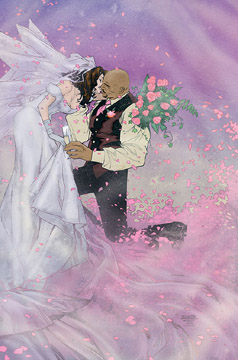 I don’t think many readers ever doubted that Jessica Jones would eventually say “Yes” to the proposal of marriage from Luke Cage, father of her new baby. But I also doubt that many of us expected it to be the occasion for writer Brian Michael Bendis to give a fond tip of the hat to the great Marvel Comics Annuals of the Silver Age.
I don’t think many readers ever doubted that Jessica Jones would eventually say “Yes” to the proposal of marriage from Luke Cage, father of her new baby. But I also doubt that many of us expected it to be the occasion for writer Brian Michael Bendis to give a fond tip of the hat to the great Marvel Comics Annuals of the Silver Age.
The story is a fun twist on the classic “Reed and Sue’s Wedding” from Fantastic Four Annual #3. Instead of a horde of supervillains attacking, though, this time it’s a horde of “New Avengers” themselves, in the form of the new Super-Adaptoid, who has the ability to absorb the powers of any superhero it faces. Now, that’s about as un-Bendis-sounding a story as you could imagine, and it’s fun to see him cutting loose with an old-fashioned super-powered throwdown.
The new version of the Super-Adaptoid was created by A.I.M. from the shattered one-time Black Widow Yelena Belova. Motivated by her desire for revenge, she crashes the team’s meeting with an already-skeptical mayor, taking on and thrashing the various members of the group. Each encounter has some great individual touches; Iron Man’s is particularly inspired, and Spider-Man’s is hilarious. The resolution to the story is just as old-school as the rest of it: it’s a plot device that’s been around at least since the Silver Age, and that’s part of the fun. The actual wedding is really a coda to the story, but it’s sweet and honest.
As he did in House of M, artist Olivier Coipel gets to work on a book stuffed to the gills with superheroes, and he keeps the action flying—and considering that the finished product has seven (!) different inkers and three different colorists, that’s no small feat. Possibly one misjudgement, though, was the inclusion of an opening splash page showing the “classic” version of The Avengers against the original Super-Adaptoid (I honestly can’t tell if it’s a recolored Don Heck page, or a modern “homage”). It’s a lot to live up to.
Of course, Michael Gaydos remains the only “real” artist for Jessica Jones; no one else has quite captured the feel of the character he co-created with Bendis in Alias. But Coipel does convey some of her self-deprecating honesty, particularly when it’s time for the exchange of vows. And the choice of clergyman is a nice grace note.
The entire New Avengers series has a slightly off-kilter feel to it, and that’s somewhat reinforced by the fact that the end of this book indicates that the story will be “continued in New Avengers #22”—which is still about three issues down the road. Still, it’s not as though it ends on a major cliffhanger, so that’s not really an impediment, just a minor annoyance in an otherwise entertaining comic.
RATING: 
![]()

Hank Ketcham’s Complete Dennis The Menace: 1953-1954 (Volume 2)
(Fantagraphic Books)
by Elgin Carver
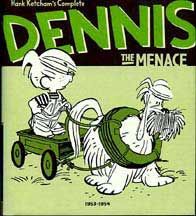 The number of comic books that approach the level of Art ( capital A) compared with comic strips is extremely low. Comic books seem to insist on the superficial, to hew to the over-dramatic, to seek out the lesser. The potential for greatness is there. As fans we all see it. But that potential is so seldom realized that one is tempted to conjecture that the potential is an illusion, until, on occasion that more than usual book arrives. Comic strips, on the other hand, reached that potential long ago. So long ago, that they reached their apex and crashed back, almost certainly never to rise again. Once Calvin and Hobbes left the newspapers, it became impossible to believe that another truly great comic strip could arise from the emasculated and diminished remains of today’s comic page.
The number of comic books that approach the level of Art ( capital A) compared with comic strips is extremely low. Comic books seem to insist on the superficial, to hew to the over-dramatic, to seek out the lesser. The potential for greatness is there. As fans we all see it. But that potential is so seldom realized that one is tempted to conjecture that the potential is an illusion, until, on occasion that more than usual book arrives. Comic strips, on the other hand, reached that potential long ago. So long ago, that they reached their apex and crashed back, almost certainly never to rise again. Once Calvin and Hobbes left the newspapers, it became impossible to believe that another truly great comic strip could arise from the emasculated and diminished remains of today’s comic page.
There have been dozens and dozens of comic strips that the cognoscente will recognize as Great Art, but only a few have been republished in sufficient depth so as to be appreciated, and one needs to read long runs of even the greatest strips in order to truly appreciate the artistic depth that their creation required. Little Nemo In Slumberland, Calvin And Hobbes, The Far Side, Prince Valiant, Wash Tubbs, Terry And The Pirates, Thimble Theatre (Popeye) are about the only ones of which complete runs can be found as books. Long stretches of Dick Tracy can be found in comic book form, and one large volume of Little Orphan Annie can be found, though, alas, an attempt to reprint the entire strip lasted only five volumes. Krazy Kat, the greatest of them all, has been and continues to be brought back in its entirety, as does The Spirit, Gasoline Alley (under the title of Walt And Skeezix), Peanuts, and Dennis The Menace. Each are worthy in their own right, some more than others, and all for different reasons.
Dennis the Menace, a single panel daily strip, is a look into the activities of an active, rambunctious five year old, his family, and neighbors. Crafted with humor, and drawn with a skill equal to any, this strip is, along with Pogo and a few others, the epitome of the strips of the 1950s, the last great general flowering of the newspaper comic strip.
There are themes within the strip that might seem repetitious at first. But where Calvin and Hobbes looks at childhood and the human condition with an adult sensitivity, Dennis the Menace looks at it from the child’s point of view, and like a child, Ketcham returns to an idea or situation and re-investigates from as many aspects as are available to the imagination.
This quality reprint and others, like Peanuts and Walt and Skeezix, deserve your complete support. Not only are they preserving a portion of our culture too many are quick to throw away and is otherwise unavailable, but no comic library is complete without them. This chunky book with its continuity and excellent commentary is done in the manner its publishers should be proud of, and you should enjoy.
RATING: 
![]()

 Seven Soldiers Frankenstein #4 (DC). Of all the Seven Soldiers series, Frankenstein’s probably the most linear—though it intersects with the other SS minis, its relationships aren’t oblique, and it does more to illuminate the overall storyline than any of the others. Frankenstein himself is, in a lot of ways, a variation on Grant Morrison’s version of Batman: driven, completely without fear or doubt, always prepared, and the smartest and most righteous guy in the room. Here, he gets to the heart of the Sheeda invasion, dispatching monsters, aliens, and witches with the same dogged “All in a day’s work… for Frankenstein.” It’s an approach that can seem facile (as Batman was in Morrison’s recent JLA:Classified run with Ed McGuiness), but Doug Mahnke’s art has a European, “Heavy Metal” touch that brings the grotesque to the fore, and gives the story more texture than it would otherwise have. It looks like it will probably be a few months before we see the grand wrapup to Seven Soldiers, but this issue answers a lot of questions, and does a nice job of clearing the decks for the finale. – Jeb D.
Seven Soldiers Frankenstein #4 (DC). Of all the Seven Soldiers series, Frankenstein’s probably the most linear—though it intersects with the other SS minis, its relationships aren’t oblique, and it does more to illuminate the overall storyline than any of the others. Frankenstein himself is, in a lot of ways, a variation on Grant Morrison’s version of Batman: driven, completely without fear or doubt, always prepared, and the smartest and most righteous guy in the room. Here, he gets to the heart of the Sheeda invasion, dispatching monsters, aliens, and witches with the same dogged “All in a day’s work… for Frankenstein.” It’s an approach that can seem facile (as Batman was in Morrison’s recent JLA:Classified run with Ed McGuiness), but Doug Mahnke’s art has a European, “Heavy Metal” touch that brings the grotesque to the fore, and gives the story more texture than it would otherwise have. It looks like it will probably be a few months before we see the grand wrapup to Seven Soldiers, but this issue answers a lot of questions, and does a nice job of clearing the decks for the finale. – Jeb D.
RATING: 
 Blue Beetle #2 (DC) – Keith Giffen and John Rogers are writing this one more serialized than episodic (so far), thus the second issue of Blue Beetle carries on in the time-jumping vein of the first, alternating between the time when Jaime first discovers his body has been infiltrated by the mystic scarab, and the time when he returns home from fighting Brother Eye with Batman and a gaggle of other heroes. There is a conflict with a mysterious gang of paranormal thugs, which spurs Jaime into his first full-on Blue Beetle assault – a sequence which is dynamically rendered by series artist Cully Hamner – exposing more of the new Beetle’s capabilities. The book is a fantastic read for all ages, and really understands the bewilderment of young, reluctant hero. I can’t say he’s Spider-Man iconic yet, but the costume is exceptionally cool, and the dialogue is fun. –Graig–
Blue Beetle #2 (DC) – Keith Giffen and John Rogers are writing this one more serialized than episodic (so far), thus the second issue of Blue Beetle carries on in the time-jumping vein of the first, alternating between the time when Jaime first discovers his body has been infiltrated by the mystic scarab, and the time when he returns home from fighting Brother Eye with Batman and a gaggle of other heroes. There is a conflict with a mysterious gang of paranormal thugs, which spurs Jaime into his first full-on Blue Beetle assault – a sequence which is dynamically rendered by series artist Cully Hamner – exposing more of the new Beetle’s capabilities. The book is a fantastic read for all ages, and really understands the bewilderment of young, reluctant hero. I can’t say he’s Spider-Man iconic yet, but the costume is exceptionally cool, and the dialogue is fun. –Graig–
RATING: 
 Invincible #31 (Image) – As foreshadowed in issue #30, Mark’s return to Earth has put “Invincible” back on track after his bizarre, father-confronting off-world adventure. After getting his mother acclimated to his new brother, Mark slowly returns to his old life in college – finding time to involve himself in a great superhero action fight (how do you beat a bad guy with zombie-inducing mind-control? Hover high above – just out of the guy’s power range – and drop large rocks until you hit him on the head) – and then taking Amber to Africa to meet up with Eve for some R-n-R. So, it looks like Mark and Amber may well be serious in the midst of their ongoing soap opera, but as the cover and the last panel suggest, Eve is indeed jealous. As with the neverending Betty versus Veronica/rock-scissors-paper/kindergarten-teacher-by-day-whore-in-the-bedroom conundrum, we know that Amber – as a blonde – would trump any Veronica. But Eve is a redhead – the crazy-fun ‘Joker’s Wild’ of the female species – meaning that, hopefully, Mark will see the light and end up with another superhero and a hot one at that. Ah, “Days of Our Lives” for nerds. – Mark
Invincible #31 (Image) – As foreshadowed in issue #30, Mark’s return to Earth has put “Invincible” back on track after his bizarre, father-confronting off-world adventure. After getting his mother acclimated to his new brother, Mark slowly returns to his old life in college – finding time to involve himself in a great superhero action fight (how do you beat a bad guy with zombie-inducing mind-control? Hover high above – just out of the guy’s power range – and drop large rocks until you hit him on the head) – and then taking Amber to Africa to meet up with Eve for some R-n-R. So, it looks like Mark and Amber may well be serious in the midst of their ongoing soap opera, but as the cover and the last panel suggest, Eve is indeed jealous. As with the neverending Betty versus Veronica/rock-scissors-paper/kindergarten-teacher-by-day-whore-in-the-bedroom conundrum, we know that Amber – as a blonde – would trump any Veronica. But Eve is a redhead – the crazy-fun ‘Joker’s Wild’ of the female species – meaning that, hopefully, Mark will see the light and end up with another superhero and a hot one at that. Ah, “Days of Our Lives” for nerds. – Mark
RATING: 
 Astonishing X-Men #14 (Marvel). Soul-searching conversation cut to the rhythms of a great action movie. Emma Frost is stripping Scott Summers down to his soul, and Joss Whedon has written the dialogue so skillfully that anyone who missed the past couple of issues might be forgiven for thinking that she was just trying to lay some difficult home truths on her lover… that is, until the genuinely horrifying last page. And frankly, even those of us that have been reading right along can’t be sure we have all the answers about Ms Frost’s motivations. The book is full of Whedon’s traditional humor and grace notes (Kitty Pryde, in particular, gets one of her greatest moments ever), and he leaves us with at least three different cliffhangers. Placing this issue back to back with last month’s Planetary #26, one is reminded again just how bloody great an artist John Cassaday is. If you’ve seen the cover, you know there’s an unexpected “encounter” depicted inside, but I guarantee you’re not prepared for what Cassaday does with it. Getting “inside the head” of Marvel’s psychic characters often comes off looking strained and artificial, but Cassaday knocks that stuff out like he invented it, pulling us deeper and deeper down a pretty scary rabbit hole. And colorist Laura Martin again proves the ideal partner: in the panel where Emma is dropping her guise of Jean to return to her natural form, note how Martin subtly shades the strands of hair we see from Jean’s red to Emma’s blond. I don’t know how many “X” books any one reader needs on a regular basis, but this is the one to start with. – Jeb D.
Astonishing X-Men #14 (Marvel). Soul-searching conversation cut to the rhythms of a great action movie. Emma Frost is stripping Scott Summers down to his soul, and Joss Whedon has written the dialogue so skillfully that anyone who missed the past couple of issues might be forgiven for thinking that she was just trying to lay some difficult home truths on her lover… that is, until the genuinely horrifying last page. And frankly, even those of us that have been reading right along can’t be sure we have all the answers about Ms Frost’s motivations. The book is full of Whedon’s traditional humor and grace notes (Kitty Pryde, in particular, gets one of her greatest moments ever), and he leaves us with at least three different cliffhangers. Placing this issue back to back with last month’s Planetary #26, one is reminded again just how bloody great an artist John Cassaday is. If you’ve seen the cover, you know there’s an unexpected “encounter” depicted inside, but I guarantee you’re not prepared for what Cassaday does with it. Getting “inside the head” of Marvel’s psychic characters often comes off looking strained and artificial, but Cassaday knocks that stuff out like he invented it, pulling us deeper and deeper down a pretty scary rabbit hole. And colorist Laura Martin again proves the ideal partner: in the panel where Emma is dropping her guise of Jean to return to her natural form, note how Martin subtly shades the strands of hair we see from Jean’s red to Emma’s blond. I don’t know how many “X” books any one reader needs on a regular basis, but this is the one to start with. – Jeb D.
RATING: 
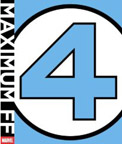 Maximum Fantastic Four (Marvel) – A hardbound oversized volume of the first issue of The Fantastic Four with commentary and analysis should be a joy to own. This monstrosity, with portions of panels on a page, willy-nilly selection of placement of individualized panels on pages, nonsensical foldouts, and superficial interpretation, combined with the price, makes this, without a single doubt, the greatest rip-off of anything placed on the market for the comic fan. That the people who conceived and designed this abomination signed their names for the entire world to see, certainly proves that beauty is in the eye of the beholder. No true fan, under any circumstances, should buy this book. I deeply regret having bought it sight unseen and relying on the publisher’s description. – Elgin
Maximum Fantastic Four (Marvel) – A hardbound oversized volume of the first issue of The Fantastic Four with commentary and analysis should be a joy to own. This monstrosity, with portions of panels on a page, willy-nilly selection of placement of individualized panels on pages, nonsensical foldouts, and superficial interpretation, combined with the price, makes this, without a single doubt, the greatest rip-off of anything placed on the market for the comic fan. That the people who conceived and designed this abomination signed their names for the entire world to see, certainly proves that beauty is in the eye of the beholder. No true fan, under any circumstances, should buy this book. I deeply regret having bought it sight unseen and relying on the publisher’s description. – Elgin